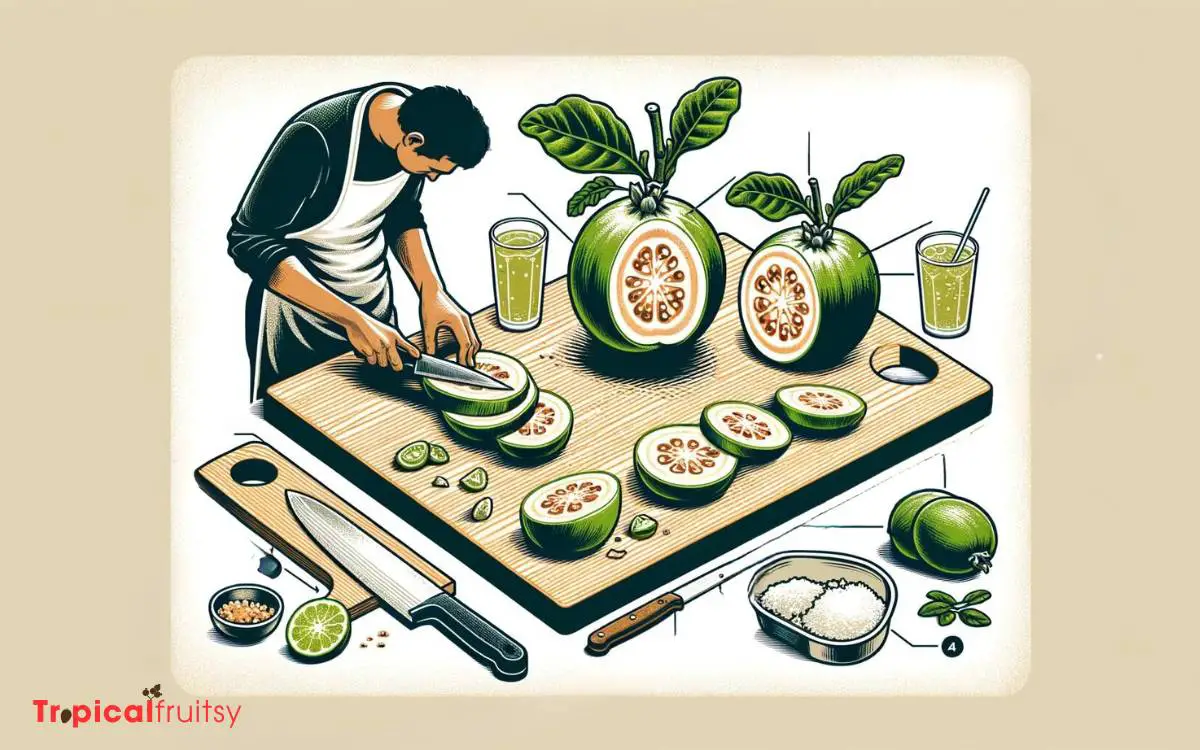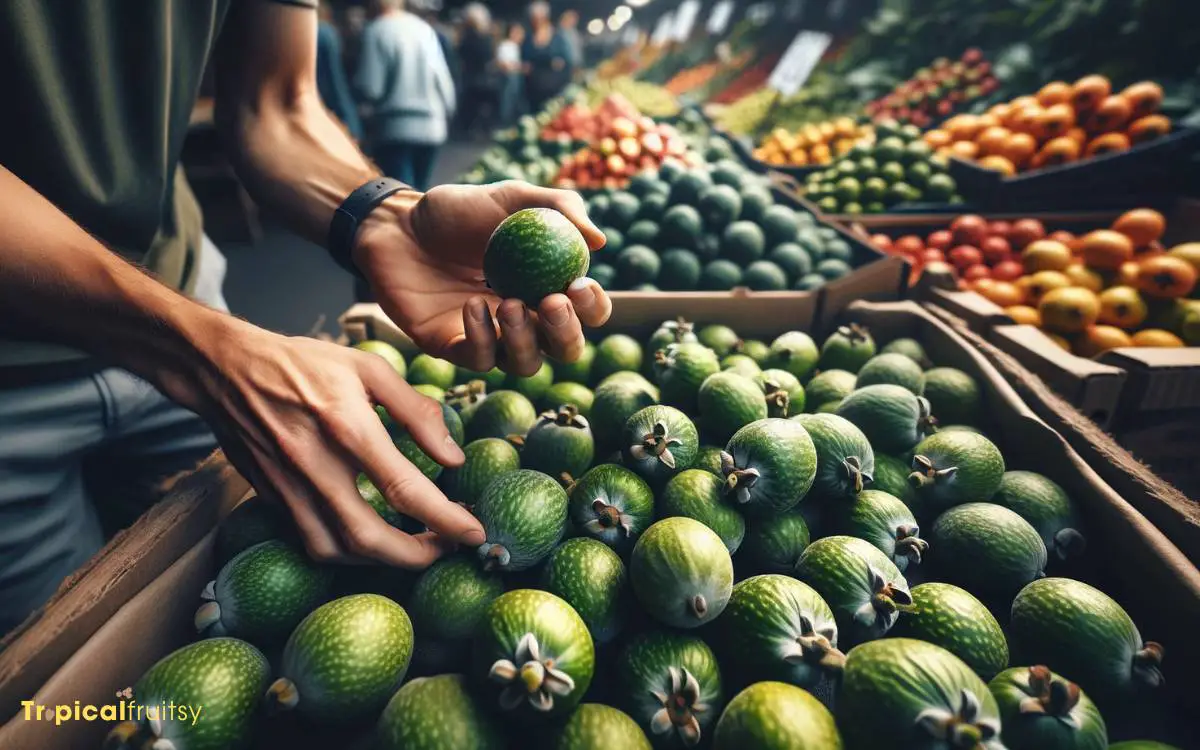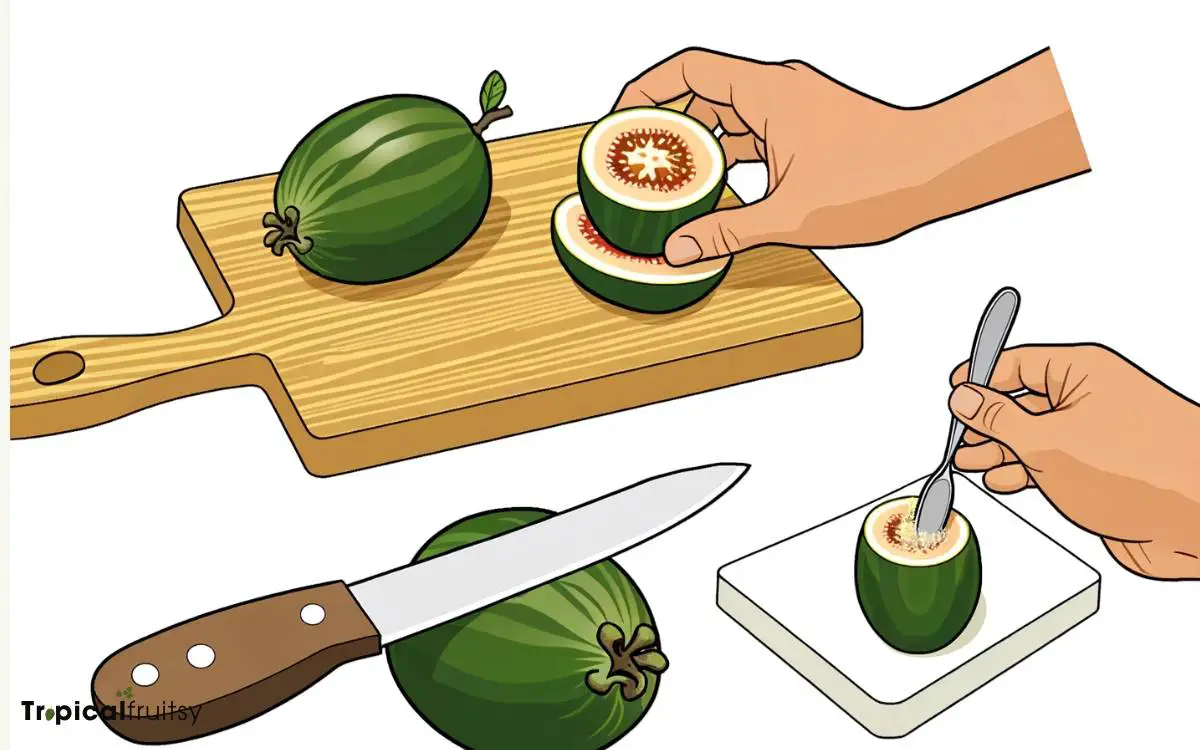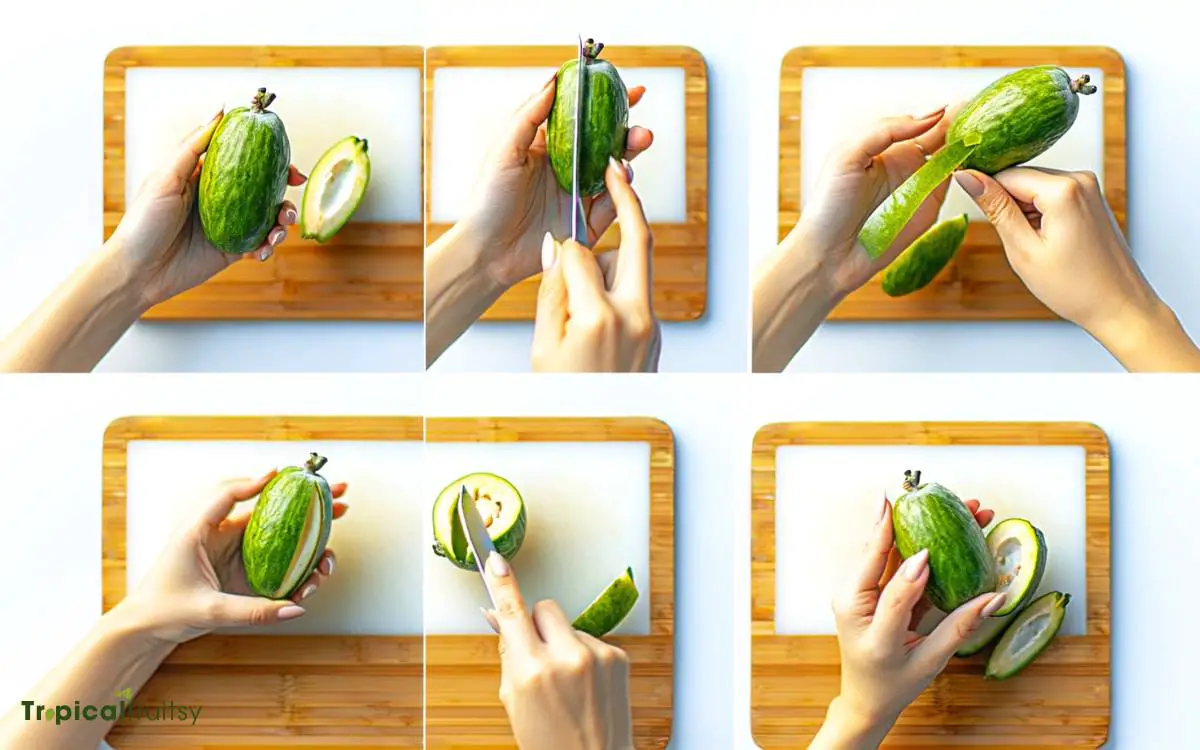How to Eat a Feijoa? 6 Easy Steps!
To properly eat a feijoa, select a ripe fruit, cut it in half, and scoop out the flesh with a spoon. Alternatively, slice it into sections and remove the skin before consuming.
Eating a feijoa involves a few simple steps:
Feijoas offer a burst of tropical flavor, perfect for a fresh snack or a creative culinary ingredient.

Key Takeaway
Step 1: Selecting the Perfect Feijoa

Choosing the right feijoa is crucial, as every piece contains its own unique flavor profile and level of ripeness. A ripe feijoa should be slightly soft to the touch, similar to a ripe avocado.
The skin may start to blemish as it ripens, which is a natural process and not indicative of the fruit’s quality.
To ensure you’re getting the full range of nutrients, such as vitamin C and dietary fiber, selecting a fruit that’s just at the point of ripeness is key.
Overripe feijoas may have a fermented taste and less nutritional value. Smell is also a reliable indicator; a sweet, aromatic scent suggests the fruit is ready to eat. Once you’ve made your choice, it’s time to prepare your feijoa for consumption.
Step 2: Preparing Your Feijoa

Once you’ve selected a ripe feijoa, it’s essential to understand the best way to prepare it for consumption.
A proper cutting technique ensures you’ll retain the fruit’s nutritious contents while deciding whether to peel or not can impact both texture and taste.
Checking for ripeness one final time before eating confirms that the feijoa offers its full health benefits and best flavor profile.
Cutting Technique
To prepare your feijoa, first wash the fruit and then slice it in half with a sharp knife. This technique exposes the succulent interior while preserving the vitamin-rich flesh.
Here’s how to maximize the health benefits with proper cutting:
- Wash thoroughly: Remove any dirt or residues that might be on the skin.
- Sharp knife: Use a sharp knife for a clean cut, which helps in preserving the fruit’s nutrients.
- Slice in half: This method exposes the edible inside while keeping the skin intact, which contains antioxidants.
- Scoop method: Use a spoon to scoop out the flesh, ensuring you get all the nutrient-rich parts.
- Avoid bruising: A gentle touch prevents bruising, retaining the fruit’s full nutritional value.
Peel or Not
While some prefer the convenience of the scoop method, others opt to peel the feijoa, a step that can enhance the fruit’s flavor and texture.
The skin of the feijoa is edible but can be slightly bitter, which some find detracts from the sweet, aromatic flesh inside. By removing the peel, eaters are left with only the succulent interior, which can be more enjoyable.
Health-wise, peeling may also be beneficial for those with sensitive digestion, as the skin contains more fiber and could be harder to digest for some.
Nevertheless, it’s essential to wash the fruit thoroughly before peeling to remove any pesticides or contaminants from the surface.
Knowing how to peel and prepare your feijoa can make all the difference, much like checking for ripeness—a critical step we’ll explore next.
Ripeness Check
Before you enjoy a feijoa, it’s crucial to determine its ripeness, as this affects both the texture and the sweetness of the fruit.
Selecting a ripe feijoa ensures you’ll get the most flavor and health benefits, as the natural sugars and nutrients are at their peak.
Here’s how to check:
- Give it a gentle squeeze: Ripe feijoas yield slightly to pressure.
- Examine the color: Look for a slight yellowing on the skin.
- Check for blemishes: Soft spots may indicate over-ripeness.
- Sniff the fruit: A ripe feijoa has a sweet, aromatic scent.
- Weight matters: A heavier feijoa for its size suggests juiciness.
Always wash the fruit thoroughly before cutting into it to remove any surface contaminants.
Enjoying a feijoa at the right stage of ripeness maximizes both the taste and the nutritional benefits.
Step 3: The Simple Peel Method

The simple peel method begins with a clean cut through the feijoa’s center. They then scoop out the antioxidant-rich flesh, which is packed with vitamin C and dietary fiber.
Lastly, they discard the peel, as it’s generally bitter and not typically consumed.
Cut in Half
Feijoas can be easily enjoyed by cutting them in half and scooping out the flesh with a spoon. This method isn’t only simple but also preserves most of the fruit’s nutritional value, which could be compromised by more aggressive peeling techniques.
Here are some key points to consider when using this method:
- Simplicity: No special tools required; a common kitchen spoon will do.
- Nutrition Retention: Less contact with air prevents oxidation, keeping the vitamins intact.
- Minimal Waste: Scooping reduces the amount of edible fruit left behind.
- Ease of Consumption: Perfect for quick snacks or adding to dishes.
- Texture Preservation: Maintains the fruit’s natural texture and juiciness.
Cutting and scooping a feijoa is a health-conscious choice, ensuring the consumer gets the full range of benefits from this nutrient-rich fruit.
Scoop Out Flesh
Once you’ve halved the feijoa, simply scoop out the flesh with a spoon and enjoy the sweet, fragrant fruit. This method not only preserves the most fruit, but it’s also quick and efficient.
The flesh of the feijoa is rich in dietary fiber and vitamin C, contributing to digestive health and immune system support.
| Step | Tool | Benefit |
|---|---|---|
| Halve | Knife | Easy access to flesh |
| Scoop | Spoon | Minimizes waste |
| Enjoy | Palate | Nutritional goodness |
Discard the Peel
After enjoying the succulent flesh, you can simply discard the feijoa’s peel, since it’s not typically eaten. The peel is tougher and more bitter compared to the sweet, fragrant inside.
While some fruits have peels that are rich in nutrients and safe for consumption, feijoa’s skin doesn’t fit this profile and is generally considered unpalatable.
When disposing of the peel, consider the following points:
- Composting: Feijoa peels are biodegradable and can enrich compost.
- Thickness: The peel’s thickness can affect decomposition time.
- Pesticides: If not organic, peels might carry pesticide residues.
- Nutritional Content: The peel lacks the fruit’s nutritional value.
- Culinary Uses: Few, if any, recipes call for the use of feijoa peel.
Opting to discard the peel is a health-conscious choice that aligns with common culinary practices.
Step 4: Slicing and Serving Ideas

Slicing a feijoa reveals its fragrant, jelly-like center, ideal for a variety of serving options. Fans of the fruit often slice it into quarters and eat the flesh with a spoon, savoring the rich, aromatic flavor.
For a health-conscious approach, feijoas can be diced and added to salads, bringing a sweet and tangy twist that’s packed with vitamin C and dietary fiber.
The fruit’s unique taste also complements yogurt or oatmeal, providing a nutritious boost to breakfast.
Chefs incorporate feijoa slices into desserts for a natural sweetness, which can reduce the need for added sugars. It’s essential to remember that feijoas are best enjoyed when ripe, as their full nutritional benefits and flavors are most prominent then.
Step 5: Cooking With Feijoas

Feijoas not only enhance fresh dishes but also add a unique flavor when cooked into jams, chutneys, or baked goods.
This fruit’s versatility in cooking stems from its aromatic sweetness with a tart edge, making it a wonderful addition to various recipes. Packed with vitamin C and dietary fiber, incorporating feijoas into meals can boost nutritional content.
Here are some delicious ways to cook with feijoas:
- Feijoa jam: Perfect as a spread for toast or a filling for pastries.
- Chutney: A zesty accompaniment for meats or cheese platters.
- Feijoa muffins: A scrumptious, healthful snack.
- Sorbet: A refreshing, tangy dessert option.
- Smoothies: Blend with other fruits for a nutrient-rich drink.
Step 6: Storing Leftover Feijoas

Once you’ve enjoyed cooking with feijoas, it’s essential to store any leftovers properly to maintain their freshness. Freshness impacts not only taste but also the nutritional value of the fruit.
To help retain the beneficial vitamins and antioxidants found in feijoas, follow these storage guidelines:
| Storage Method | Expected Shelf Life |
|---|---|
| Refrigerator (whole fruit) | 3-5 days |
| Refrigerator (cut fruit) | 1-2 days |
| Freezer (pureed or whole) | 6-8 months |
| Counter (at room temperature) | 1-2 days |
| Airtight container (refrigerated) | 2-3 days |
Refrigerating the whole fruit can extend its life, while cut fruit should be eaten more quickly.
Freezing is an option for longer preservation, but it’s important to note that texture and flavor can be affected. Always use an airtight container to prevent drying out and oxidation.
Conclusion
In the dance of dining, feijoas take center stage with their unique flavor and health benefits. One’s palate rejoices with every bite, whether it’s the simplicity of a peeled snack or the culinary twist in cooked delights.
Remember, to savor feijoas at their best, store them wisely. This fruit not only tantalizes taste buds but also nourishes the body, proving that good things do come in small, delectable packages.
Feast on feijoas, and let health and pleasure intertwine.






